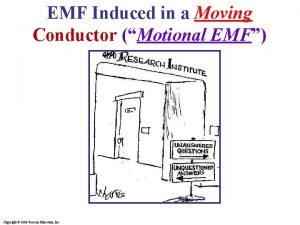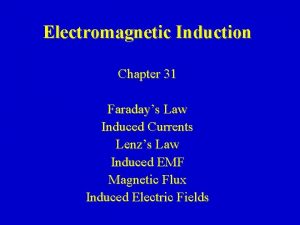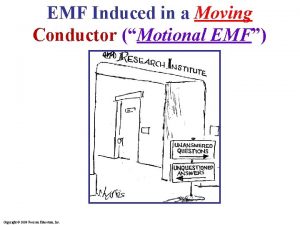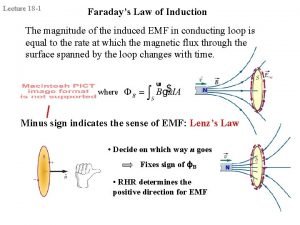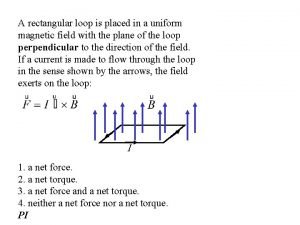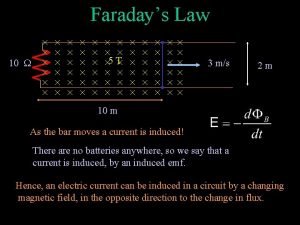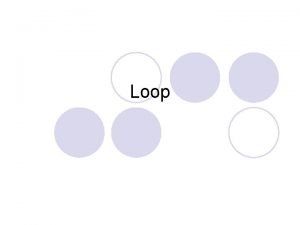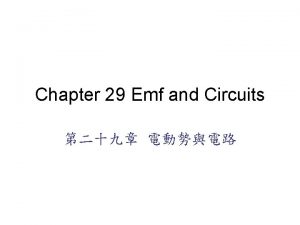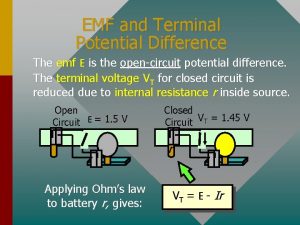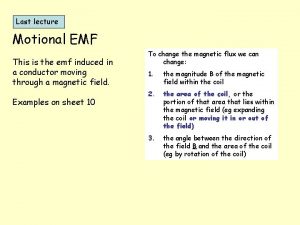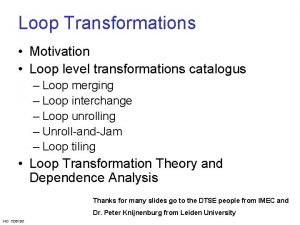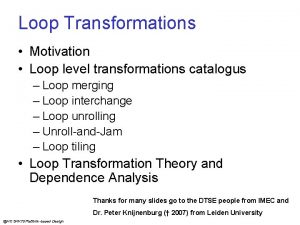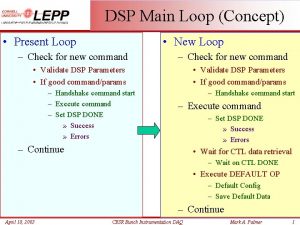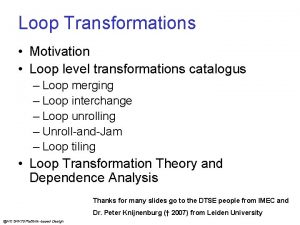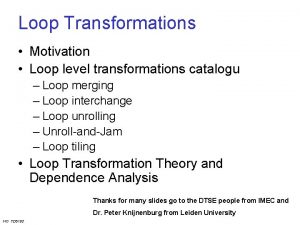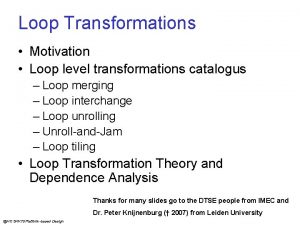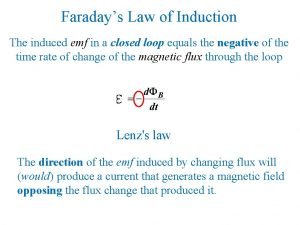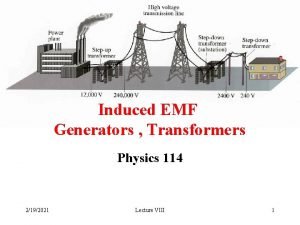An emf is induced in a conducting loop















- Slides: 15

An emf (ε) is induced in a conducting loop whenever the magnetic flux ( ) is changing. ε= t Notes: 1) / t = rate of change of flux 2) Induced emf causes induced current in the loop 3) Induced current causes its own magnetic field 4) This new B-field direction opposes the change in the original one. This part is called Lenz’s Law. 5) If there are multiple loops (Solenoid): = -N ε t (N = number of turns) Flux linking coil = 4 3 5 2

Change in Flux Induced emf Lenz’s Law Number of Turns Time for Change

Dt At t = 0 Fo = BA = BLx B v After Dt F = Fo + DF F = BLx + BLDx DF = BL(v. Dt) x Dx L

v Work done by force L q F v EMF Force on charge

• A rod of length L moves perpendicular to a field B at speed v. L ++ - • Using the Slap hand rule means electrons pushed to front B F = Ee • F = Bqv F = Bev • Eq = Bqv (ℇ/L) q = Bqv ℇ = BLv • As more electrons get pushed to front an electric field grows • Electric force (F=Eq) will balance magnetic force Eq = Bqv ℇ/L = Bv (here q = e) • Let E = ε / L ℇ = BLv (assume the rod is a capacitor ~ E=V/d)

Magnetic flux will change if the angle between the loop and the field changes:

Magnetic flux will change if the area of the loop changes:

20 cm x x x x B = 2. 0 T 3. The wire loop has a resistance of 20 m. If its area is reduced to zero in a time of. 20 s, find the magnitude and direction of the induced current.



1. A 9. 6 -cm-diameter circular loop of wire is in a 1. 10 -T magnetic field. The loop is removed from the field in 0. 15 s. What is the average induced emf? 2. A 10. 2 -cm-diameter wire coil is initially oriented so that its plane is perpendicular to a magnetic field of 0. 63 T pointing up. During the course of 0. 15 s, the field is changed to one of 0. 25 T pointing down. What is the average induced emf in the coil?

3. The moving rod is 12. 0 cm long and is pulled at a speed of 15. 0 cm/s. If the magnetic field is 0. 800 T, calculate (a) the emf developed in the rod. (b) the electric field felt by electrons in the rod.

4. The moving rod is 13. 2 cm long and generates an emf of 120 m. V while moving in a 0. 90 -T magnetic field. (a) What is its speed? (b) What is the electric field in the rod?

5. The rod moves with a speed of 1. 6 m/s is 30. 0 cm long, and has a resistance of 2. 5 W. The magnetic field is 0. 35 T, and the resistance of the U-shaped conductor is 25 W at a given instant. Calculate (a) the induced emf, (b) the current in the U-shaped conductor (c) the external force needed to keep the rod’s velocity constant at that instant.

6. A square loop 24. 0 cm on a side has a resistance of 5. 20 Ω. It is initially in a 0. 665 -T magnetic field, with its plane perpendicular to B but is removed from the field in 40. 0 ms. Calculate the electric energy dissipated in this process.
 Emf induced in a moving conductor
Emf induced in a moving conductor Faradays law
Faradays law Emf induced in a moving conductor
Emf induced in a moving conductor Faradays law
Faradays law Intermolecular forces vapor pressure
Intermolecular forces vapor pressure A conducting loop is halfway into a magnetic field
A conducting loop is halfway into a magnetic field A square conductor moves through a uniform
A square conductor moves through a uniform Open loop vs closed loop in cars
Open loop vs closed loop in cars Multi loop pid controller regolatore pid multi loop
Multi loop pid controller regolatore pid multi loop Manakah yang lebih baik open loop atau close loop system
Manakah yang lebih baik open loop atau close loop system Diagram blok pemanggang roti
Diagram blok pemanggang roti Statement while... wend digunakan untuk
Statement while... wend digunakan untuk Fifth gear loop the loop
Fifth gear loop the loop Accidental whorl
Accidental whorl Faradays law
Faradays law Thermocouple emf formula
Thermocouple emf formula
